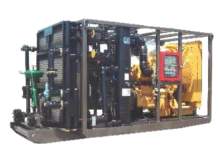
Marine drilling platforms are equipped with riser tensioner cylinders. The cylinders extend and retract to compensate for the rise and fall of the platform caused by the motion of waves and wind. The cylinders keep a constant tension on the risers. If the tensioners were not there, the riser would stretch and be damaged as the platform moves upward and crushed as the platform moves downward.
The tensioner cylinders are typically air over oil hydraulic cylinders. The cylinders are supported by up to 25 air pressure vessel banks holding 70.6 ft3 (2000 liters) in each vessel up to 4350 psig (300 barg) per tensioner. A high pressure compressor maintains the pressure in the vessels to account for leakage. These high pressure vessels pose a considerable safety hazard. Not only are the vessels at high pressure, they are filled with air that can support combustion. In the event of a fire, a rupture of these vessels would release over a half million cubic feet of air to fan the flames. Replacing the air in these vessels with inert nitrogen significantly improves system safety as nitrogen does not support combustion. With nitrogen, in the event of a fire and vessel rupture, the released nitrogen would act to suppress the flames and improve platform safety.
Onboard nitrogen generators are becoming more and more common as a source for high pressure gas, replacing air. A nitrogen generator safely separates oxygen and nitrogen from a compressed air supply. A high pressure booster raises the pressure of the generated nitrogen to 4500 psig. Nitrogen is an inert gas that does not support combustion.
Please download this market application publication for more information.

